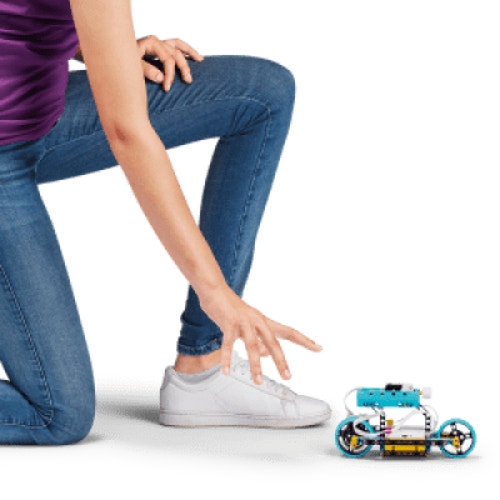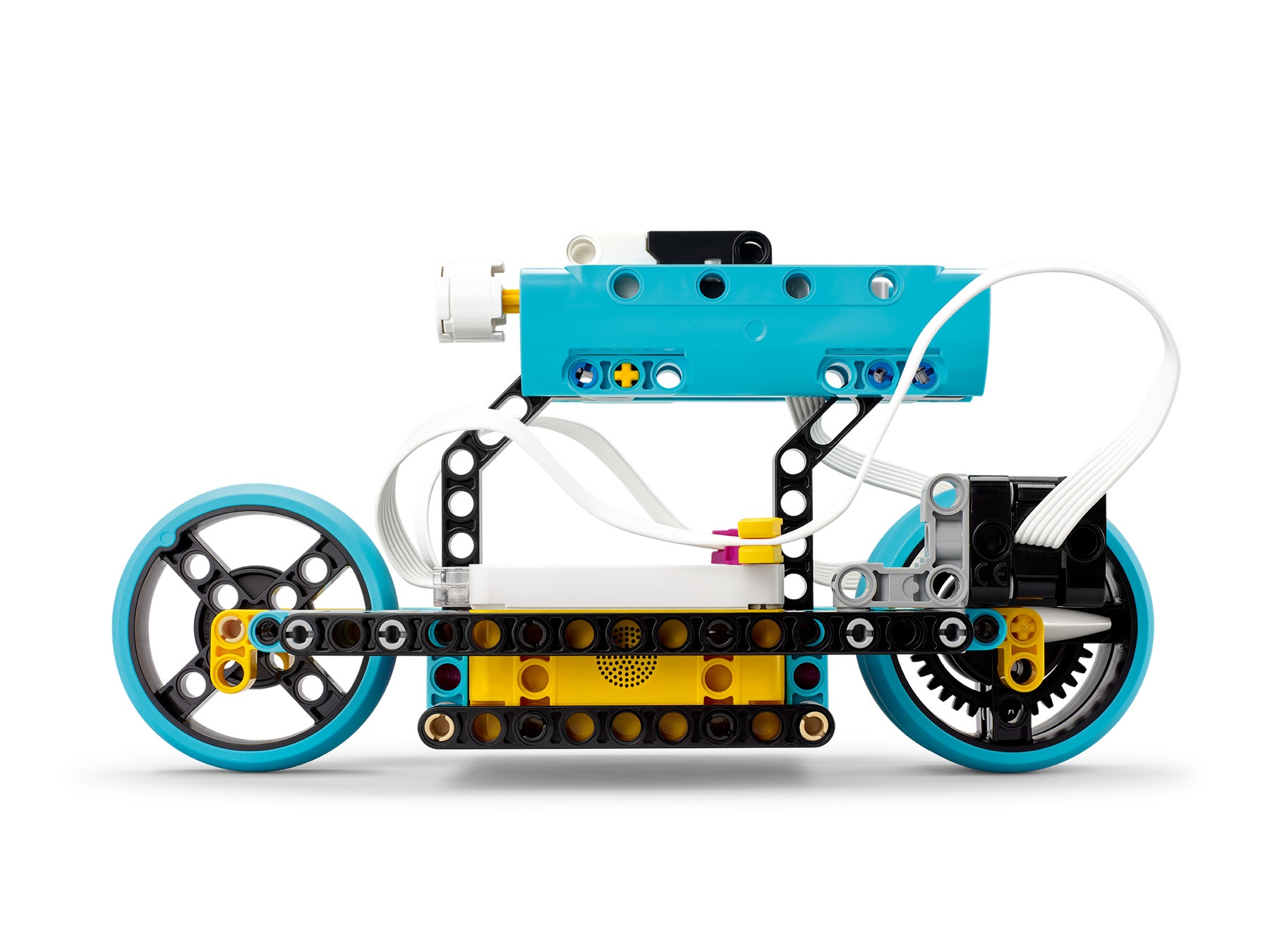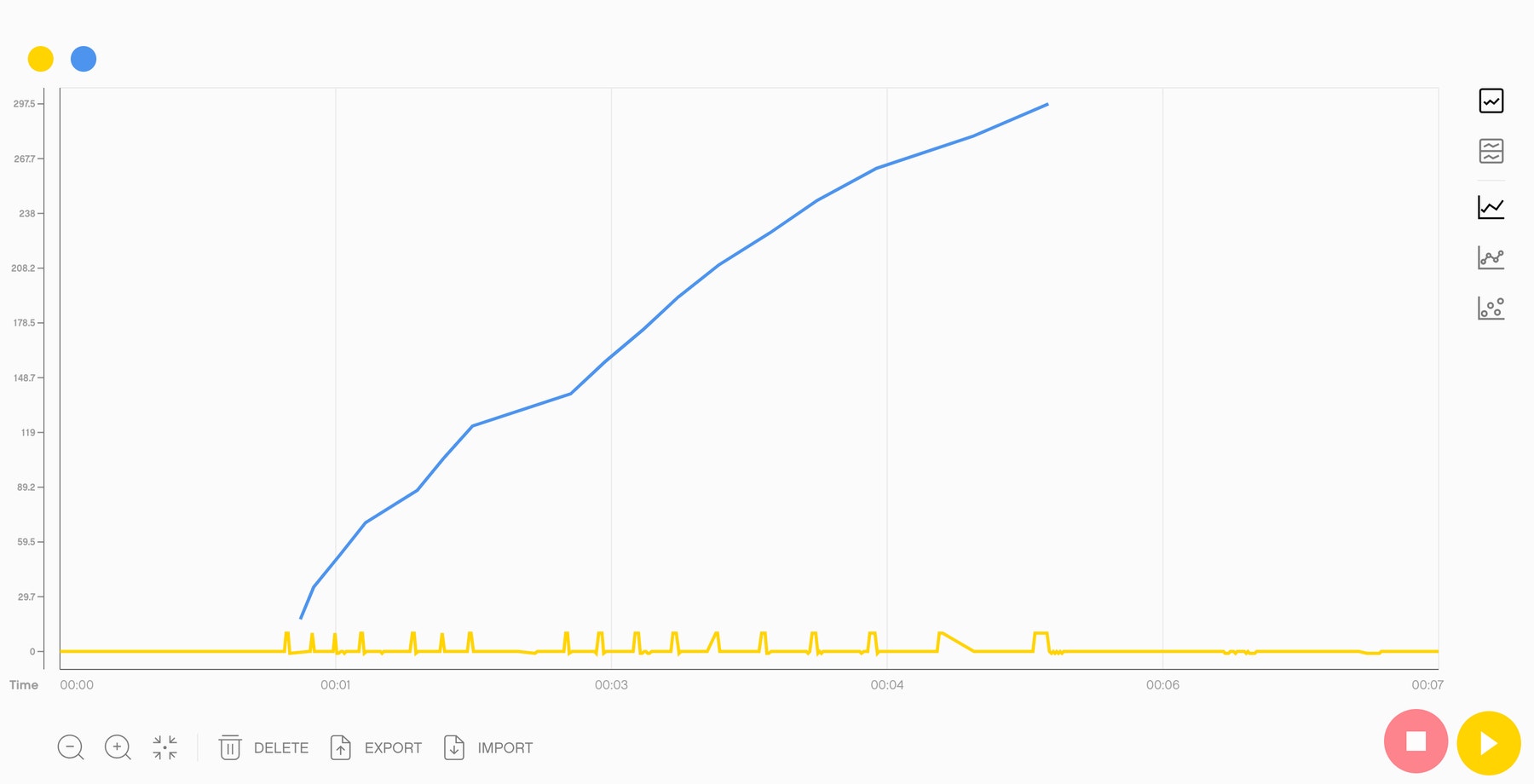Aim for It
Explore kinetic energy during a movement using variable speed.

Engage
(Before Class, 20 Min.)
- This lesson explores how kinetic energy relates to speed and mass. Your students will perform an experiment that focuses on measuring the distance traveled over time, using wheel rotation as input. Using a graph showing rotations of a wheel over time, they'll trace a graph showing the distance traveled over time, and then try to graph the speed over time. Finally, they'll use the maximum speed value to calculate the kinetic energy using the formula: Ek = ½mv2 m = 305 g
- Use various materials to engage your students on the topic of kinetic energy.
Ignite a Discussion
Start a discussion by asking questions related to the lesson. Here are a few suggestions:
- What does the graph showing the distance traveled over time look like?
- What does the graph showing speed over time look like?
- What does the graph showing kinetic energy over time look like?
Have your students write down their thoughts as a hypothesis.
Explore
(In Class, 30 Min.)
- Have your students build a vehicle with free-moving wheels, and that can count wheel rotations. They can create their own models, or follow the building instructions in the app to build the Street Curling Rock model.
- Ask your students to try out their models using the suggested program.
- Have them trace a graph of the distance traveled over time, and describe what they see:
- What do the spikes in the graph represent?
- Why does the space between the spikes increase as time goes by?
Explain
(In Class, 15 Min.)
- Have your students continue the experiment by:
- Converting the rotations per seconds into distance
- Converting the distance traveled over time into speed
- Allow your students some time to adjust their programs to improve performance.
- Encourage them to record as much data as possible during their experiments.
- Have them export their data as a CSV file, so they can manipulate it in other software if they wish.
Elaborate
(After Class, 20 Min.)
- If your students still have access to their SPIKE Prime Sets, have them complete the tasks from the SPIKE App, to elaborate with hands-on learning, for example:
- Have your students play a game while logging their performance in their throws. Tell them to push their street curling rocks, attempting to have the front of the model stop as close as possible to the center of the target. Explain that each student or team has 3 tries, and must measure the distance from the center of the target to the front of their model after each attempt. The student or team with the smallest cumulative distance after 3 tries wins the game!
- If your students don't have access to their sets, have them complete their Student Inventor Notebook, or assign one of the extension activities suggested below. Most of the extension activities can be done using the data collected during the hands-on session
- Facilitate a sharing session in which your students exchange information. This can be done using whichever method/tool is most efficient (i.e., in-person or online).
Evaluate
- Give feedback on each student's performance.
- You can use the assessment rubrics provided to simplify the process.
Assessment Opportunities
Teacher Observation Checklist
Establish a scale that meets your needs, for example:
- Partially accomplished
- Fully accomplished
- Overachieved
Use the following success criteria to evaluate your students' progress:
- The students can program a device to log datae on a line graph..
- The students can interpret the values coming from the line graph.
- The students can explain kinetic energy in relation to speed.
Self-Assessment
Have each student choose the brick that they feel best represents their performance.
- Blue: I can graph data using the program provided in the app.
- Yellow: I can create my own line graph and explain my results.
- Violet: I've created new experiments on my own.
Peer-Assessment
Encourage your students to provide feedback to others by:
- Having one student score the performance of another using the colored brick scale above.
- Asking them to present constructive feedback to each other so that they can improve their performance during the next lesson. This is a great opportunity to use videoconferencing tools or blog posting tools in a blended learning scenario.

Differentiation
Simplify this lesson by:
- Limiting the lesson's focus to variations of the distance traveled over time
Take this lesson to the next level by:
- Asking your students to design and build their own freewheeling vehicles and curling rocks, repeat the experiment, and compare their data with other model performance (e.g. from another student's data).
- Having your students design and build their own pushing devices that can provide more regular throws, and document the design process

Tips
Building Tips

Coding Tips
This lesson is designed to be played while the hub is connected through USB or Bluetooth. While connected, the data collected by the Hub is streamed directly to your device, and traced in real-time on the Line Graph.
Main Program

Solution Program

Science Data Tips
Here is an example of the data students can expect from this experiment.

Extensions
Math Extension
To incorporate the development of math skills:
- Have your students explore what happens when they change their curling rock's mass by adding elements (e.g., motors) or a heavy object (e.g., a water bottle). Ask them to update their models, rerun the experiment, and compare the graphs showing speed over time for the different masses.
Note: This will require additional time.

Language Arts Extension
To incorporate the development of language arts skills:
- Ask your students to create a marketing campaign promoting the key features of their models. Tell them to include their model's technical characteristics and use scientific facts related to the concepts of speed and energy to highlight their benefits.
Note: This will require additional time.

Career Links
Students who've enjoyed this lesson might be interested in exploring these career pathways:
- Education & Training
- Health Science
Teacher Support
Students will:
- Calculate initial speed for a decelerating movement from a graph showing the distance traveled over time
- Use this approximated speed to calculate the average kinetic energy
LEGO® Education SPIKE™ Prime Set
Device with the LEGO Education SPIKE App installed
NGSS
MS-PS3-4
Plan an investigation to determine the relationships among the energy transferred, the type of matter, the mass, and the change in the average kinetic energy of the particles as measured by the temperature of the sample.
Common Core
CCSS.MATH.CONTENT.7.RP.A.2
Recognize and represent proportional relationships between quantities.
CCSS.MATH.CONTENT.7.RP.A.2.A
Decide whether two quantities are in a proportional relationship, e.g., by testing for equivalent ratios in a table or graphing on a coordinate plane and observing whether the graph is a straight line through the origin.
CCSS.MATH.CONTENT.7.RP.A.2.B
Identify the constant of proportionality (unit rate) in tables, graphs, equations, diagrams, and verbal descriptions of proportional relationships.
CCSS.MATH.CONTENT.7.RP.A.2.C
Represent proportional relationships by equations. For example, if total cost t is proportional to the number n of items purchased at a constant price p, the relationship between the total cost and the number of items can be expressed as t = pn.
CCSS.MATH.CONTENT.7.RP.A.2.D
Explain what a point (x, y) on the graph of a proportional relationship means in terms of the situation, with special attention to the points (0, 0) and (1, r) where r is the unit rate.
CCSS.ELA-LITERACY.W.7.2
Write informative/explanatory texts to examine a topic and convey ideas, concepts, and information through the selection, organization, and analysis of relevant content.
CCSS.ELA-LITERACY.W.7.2.A
Introduce a topic clearly, previewing what is to follow; organize ideas, concepts, and information, using strategies such as definition, classification, comparison/contrast, and cause/effect; include formatting (e.g., headings), graphics (e.g., charts, tables), and multimedia when useful to aiding comprehension.
CSTA
2-CS-02
Design projects that combine hardware and software components to collect and exchange data.
2-DA-09
Refine computational models based on the data they have generated.
ISTE
4a
Students know and use a deliberate design process for generating ideas, testing theories, creating innovative artifacts or solving authentic problems.
4b
Students select and use digital tools to plan and manage a design process that considers design constraints and calculated risks.
4c
Students develop, test and refine prototypes as part of a cyclical design process.
5b
Students collect data or identify relevant data sets, use digital tools to analyze them, and represent data in various ways to facilitate problem-solving and decision-making.
5d
Students understand how automation works and use algorithmic thinking to develop a sequence of steps to create and test automated solutions.




